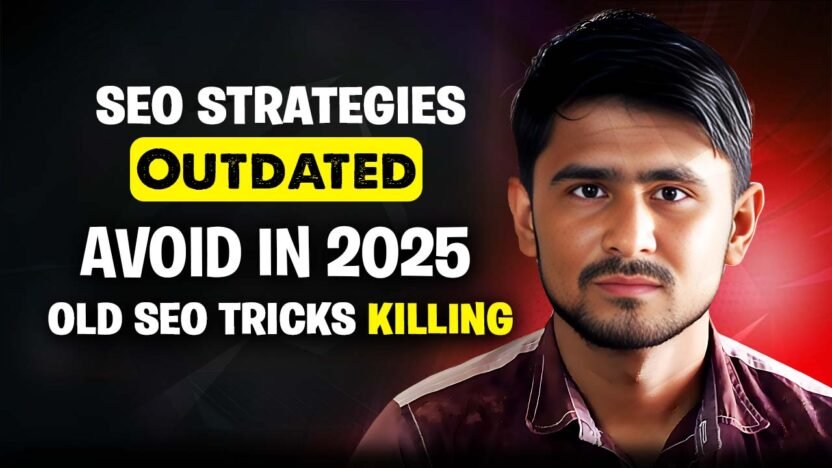How Old SEO Tricks Are Killing Your Website in 2025
If you are still using some old SEO techniques in 2025, then stop using them now or else your website’s ranking can be lost.
Have you ever felt that you worked hard, invested time and money in SEO, but still your website got penalized? This is happening with many people.
The problem is usually the same as in front of us – the SEO techniques you are using either become outdated or become spammy without you noticing. And the result? All your hard work goes to waste.
But now that’s enough.
Why You Need to Update Your SEO Strategy
This guide will tell you which old SEO practices should be abandoned immediately. And we will also talk about a controversial spam trick that still works today, but comes with risks.
The biggest issue is that the SEO blogs you read are 2-4 years old. They just update the title to “2025”, but inside there is the same old, useless content. Now the time has come to separate truth from lies.
Let’s see those SEO secrets that will protect your site as well as grow it.
The Pitfall of Keyword Stuffing in SEO
First of all let’s talk about a common trap – Keyword Stuffing.
Everyone knows that keywords are the base of SEO. But there is a line between smart use and overuse. Many people cross that line when they put the same keyword repeatedly in every sentence, heading, and paragraph – whether it is necessary or not.
This is an old black-hat trick, and Google’s algorithms have become so smart now that they catch it instantly.
When the user reads the same word repeatedly, the content starts getting boring. The interest is lost, he leaves the page and goes away, and the bounce rate increases. Google gets a signal that this content is not valuable.
Modern Solution: Embrace Semantic SEO
Now what is the modern solution for this? Use Semantic SEO.
In this technique, you do not repeat the same keyword again and again. Rather, you use related words, synonyms, and concepts around that keyword naturally. For example, if your keyword is “best gaming laptop,” then you should also naturally use these terms:
- High-performance notebooks
- Graphics card
- RAM and storage
- Laptop for gamers
- Battery life
- Screen refresh rate
This approach helps Google understand the context and depth of your content. And the real people who are reading it also understand the content naturally and find it useful.
Avoid Creating Separate Pages for Every Keyword
In the next part we will talk about more outdated SEO techniques. If you are ready then paste the next content.
Creating a separate page for every keyword – don’t make mistakes.
Another common mistake people make is – if they have a list of similar keywords, then they create a separate page for each keyword.
Like:
- best-gaming-laptop
- best-gaming-laptop-2025
- top-gaming-laptops-in-2025
The Problem with Keyword Cannibalization
This technique is called keyword cannibalization. You are making your own website pages compete against each other. This weakens your authority and Google gets confused as to which page to rank.
The smart way is to group all keywords with the same search intent together, i.e. create a cluster, and target them in a single strong page. Today Google has become so smart that it can rank a single powerful article for thousands of related searches. This is called real semantic SEO.
Don’t Write Content Just for Google
Content written only for Google – don’t do this.
Many people get so involved in keyword research and technical SEO that they forget that the person reading the article is a human, not a robot. Such content is just filled with keywords, but there is no value, no insight, no readability.
Google’s main goal is to give the best answer to the users. If your content looks robotic, Google immediately understands.
Prioritize Quality Over Quantity
Quality is always better than quantity. Google does not say that you should publish four average articles every day, it wants you to write one best article on the topic you are writing on – that is enough.
The Dangers of Using Spun Content
Use of Spun Content – You will ruin your website while trying to save time.
Spinning means taking someone else’s article, modifying it a little with a tool, and publishing it in your name. Please, never do this.
Google’s algorithms easily identify spun, copied or low-quality content. Its direct result is penalty and ruining the reputation of your website.
Create Authentic Content
The solution is simple – write in your own voice.
Use your experience and knowledge. Create a unique style – whether you are funny, technical or write like a simple teacher, make it your identity. This will make your audience loyal and your brand will grow.
Exact Match Domains (EMDs) Are No Longer Enough
Rely on Exact Match Domain (EMD) – Now that time is gone.
There was a time when getting a domain like “BestGamingLaptops.com” was considered a ticket to Google top ranking. But now it is not so.
Even today EMD can help a little, but it does not give the effect like magic. Now the real power comes when you make that domain a recognizable brand.
If people start searching for “Best Gaming Laptops” with a brand name, then you have won.
But for most websites, especially ecommerce stores, a creative and brandable name is more valuable than a generic keyword stuffed domain.
Avoid Overusing the Same Anchor Text
Same Anchor Text in Every Link – Alerts Google.
Anchor text means the text on which a link opens when clicked. Now the mistake is that people use the exact same keyword every time for the link.
For example, if you link to your gaming laptop page 50 times, and every link says “best gaming laptop”, then Google thinks that something is suspicious.
Diversify Your Anchor Text
A better solution is to mix anchors –
- Partial match: “these gaming laptops are great”
- Branded: “check out our guide on [Your Brand Name]”
- Naked URL: “www.yoursite.com/gaming-laptops“
- Generic: “click here”, “read more”
It should look natural, not manipulated.
Mobile SEO: Don’t Ignore the Mobile Experience
Ignoring mobile experience – will not work at all in 2025.
Today, more than half of the people visit websites from mobile. But still many sites are designed only as per desktop.
Your site should be fast, smooth and easy to use on every screen size.
Mobile SEO Checklist
A short mobile SEO checklist:
- Is it responsive? It should adjust well on every device.
- Is it fast? It should load in less than 2 seconds on mobile. Test with Google PageSpeed Insights.
- Is it easy to use? Buttons should be large, and there should be no irritating popup blocking the content in between.
The Risks of Private Blog Networks (PBNs)
A warning about Private Blog Networks (PBNs).
Let’s now talk about the topic that is on everyone’s mind but people do not discuss it openly – PBNs, i.e. Private Blog Networks. Some SEOs say they are dangerous, some say they have become useless. The truth is that they are very risky, but if done properly, they can also give some benefit.
But first one clear thing – using PBN is a black-hat technique which is against Google’s rules. If caught, Google puts a manual penalty on your site. This information is only for educational purpose.
Common PBN Mistakes to Avoid
Most people make mistakes while creating PBN:
- They use shared IPs
- They use low-quality or useless expired domains
- They copy-paste duplicate content
Google can easily track such signals.
Tips for Safer PBNs (If You Choose to Take the Risk)
If you still want to take the risk, then the relatively “safe” method is:
- Use high-authority and clean expired domains
- Get a different IP address for each site
- Use different themes, plugins and layouts
- Publish unique and relevant content on each site
- Don’t just link to money sites, link to some authority sites too
- Put links in between the content, not from the homepage
But remember one thing – setting up and maintaining a proper PBN is very expensive and time-consuming work.
For 99% of website owners, it is not worth taking this risk.
Evolve with SEO for Long-Term Success
Last thing – evolve with SEO.
The world of SEO is changing all the time. Things that used to work earlier, can now cause harm to your site.
The simple formula for long-term success is – stop looking for shortcuts and focus on creating real valuable content that works for people.
When you ditch outdated techniques and adopt a modern and user-friendly SEO approach, only then you create a strong base that can survive every algorithm update.





